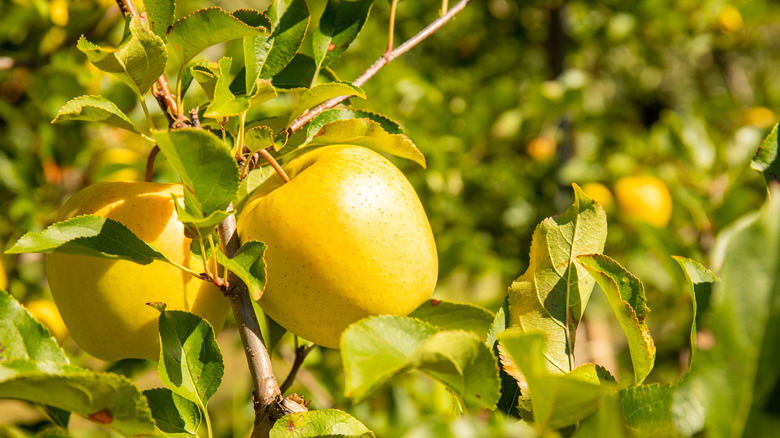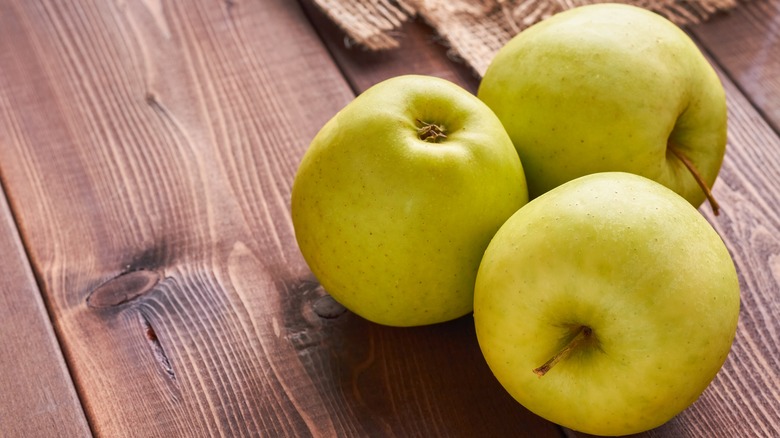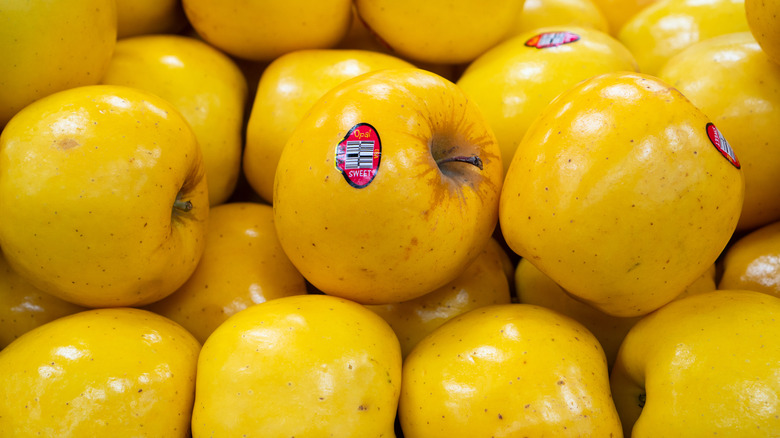The Differences Between An Opal Apple And A Golden Delicious
One of the few rivals to the crunch of fall leaves is the crunch of a fresh, juicy apple. A good bite leaves behind a small puddle of juice in the newly formed crater, and the satisfaction continues as the piece of apple is chewed further, the crunch echoing through the skull. As the apple slowly turns to pulp and is swallowed, the number one thing on the mind is the perfectly sweet and ever so slightly sour flavor left behind. Such is the experience of eating and reaping the benefits from the perfect apple.
Many people find this experience with a reliable Honeycrisp or McIntosh apple, but there are also yellow varieties of apples up to the task of delivering a memorable multi-sensory experience. Most notably: Golden Delicious and Opal. These varieties may seem indistinguishable on the surface since they are both yellow, crunchy, and sweet, but their histories and difference in browning properties set them apart.
Other apples branch off from the Golden Delicious
In 1912, a West Virginian discovered a mostly yellow, slightly green apple and sold its tree to Stark Brothers Nurseries, which then gave the apple variety its name: Golden Delicious. This variety quickly rose to fame, taking the fruit world by storm with its distinctly sweet and crunchy characteristics. West Virginia takes pride in being the place where it all started, and features the Golden Delicious as its state fruit and celebrates it annually at the Clay County Golden Delicious Festival.
In addition to being one of the best types of apples for baking, the Golden Delicious is a popular genetic ancestor to many apples because of its ability to pass on its favorable traits. The Golden Delicious apples host a remarkable 57,000 genes, which eases the production of fruit with favorable characteristics and makes the crossbreeding potential of Golden Delicious undeniable. The good genes of Golden Delicious are the reason we have the Pink Lady, Gala, and Jonagold varieties of apple; if you know how to use these types of apples, you can spot the traits that stem from their Golden Delicious parentage.
Opal apples are the golden child
Opal apples were first bred in the Czech Republic in the 90's as a cross between Golden Delicious and Topaz apples. This variety of apple features a satisfying crunch, perfectly sweet flavor, and eye-catching dandelion yellow hue. While it is a fact of life that many apples will brown after they are cut, peeled, or bitten, Opal apples will not let you down. Known for its resistance to browning, this variety is a great choice for a fruit salad, kid-friendly apple wedge dessert in the lunchbox, or other culinary pursuits that would benefit from a beautiful slice or chunk of apple.
The popularity and appeal of opal apples sit in contrast with their limited quantity. Because opals are now only grown at FirstFruits Farms in Washington, the number of apples that can be found in United States grocery stores or vendors is limited. Opal apples are only in season from November to June, so keep an eye out for their reappearance so you don't miss the chance to experience what makes them so different from others.


